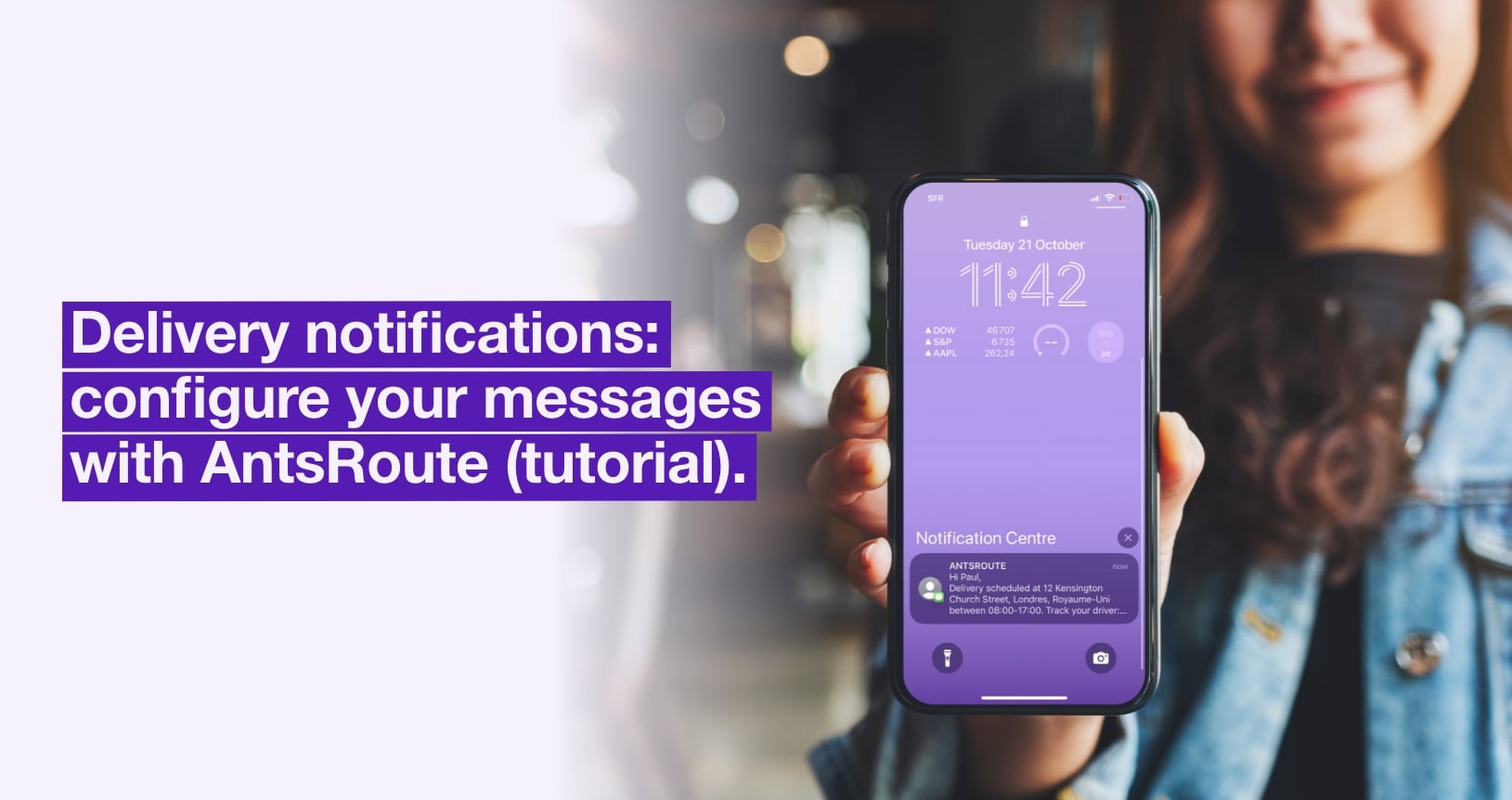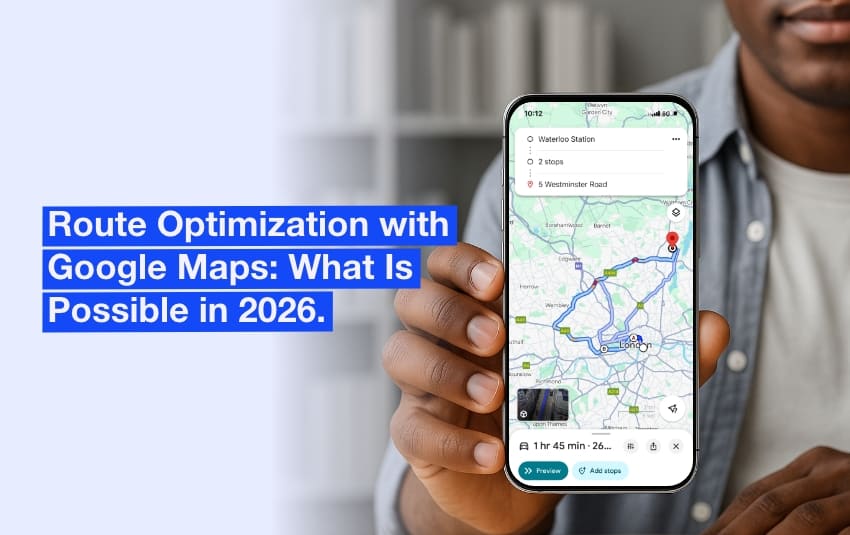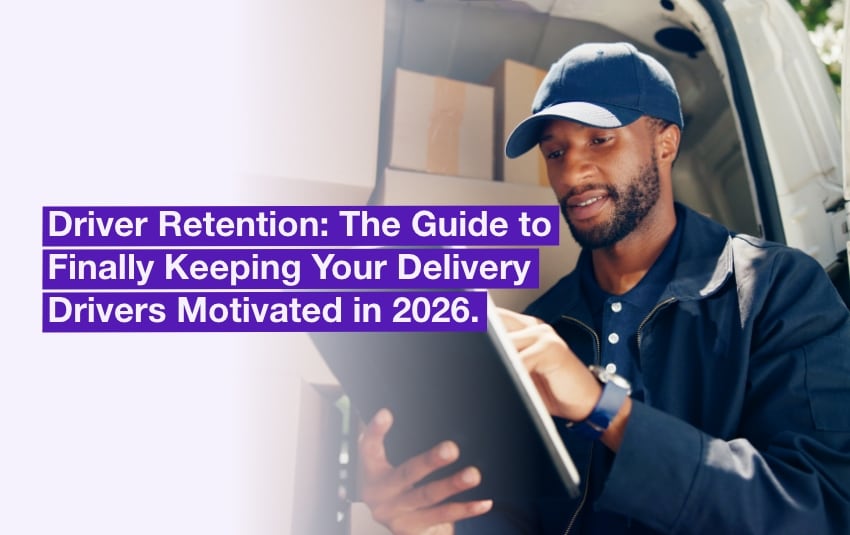Delivery notifications: configure and automate your messages with AntsRoute (tutorial & templates)
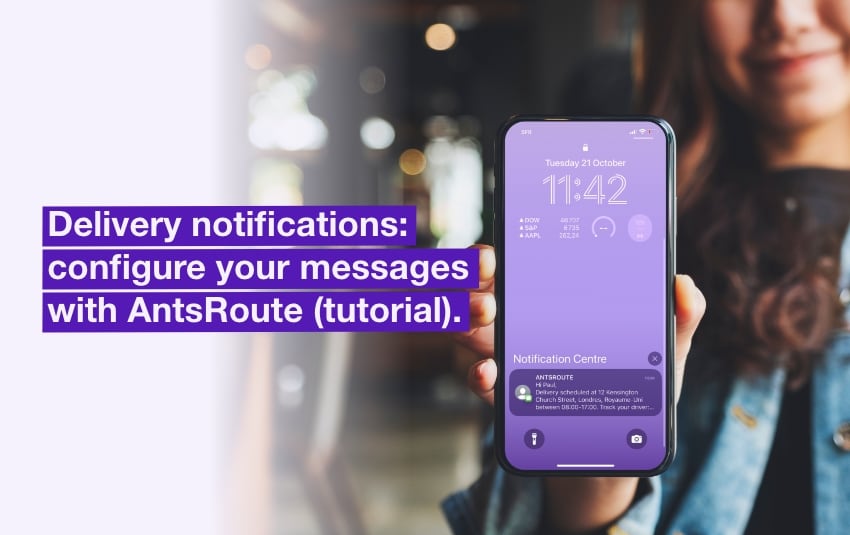
Delivery has become a true moment of truth. Beyond price and product, it’s the delivery experience that triggers satisfaction, or disappointment.
Along this journey, notifications play a key role: they reduce post-purchase anxiety, cut inbound calls, and boost the first-attempt success rate. With AntsRoute, you can deploy a multichannel (SMS, email), personalized, and actionable notification system, from appointment scheduling to the post-visit report.
What customers expect
- Reliable arrival times (dynamic ETA).
- Real-time map tracking.
- One-click actions: confirm, reschedule, report an absence.
- Transparency after the visit: proof, report, rating.
This guide shows you how to orchestrate these messages at the right time, with the right content and the right channel, to hit your goals: increase the first-attempt success rate, reduce failure-related costs, and raise NPS (Net Promoter Score). We also share message templates, UX and deliverability best practices, and the KPIs to track.
Table of contents:
- What your customers really expect
- Setup in AntsRoute: step-by-step guide
- The ideal notification journey: from first contact to feedback
- Summary table of AntsRoute notifications
- Ready-to-use message templates
- UX best practices (content, timing, channels)
- Measuring impact: the KPIs that matter
What your customers really expect
- Real-time visibility: a map and a credible estimated time of arrival (ETA) that refines as the route progresses.
- Ability to act: a link to confirm or reschedule in one click, without going through support.
- Simplicity: short, precise messages, a clear CTA, and no unnecessary friction.
- Post-delivery transparency: proof of delivery (photos, signature, timestamp), a report, and a link to leave feedback.
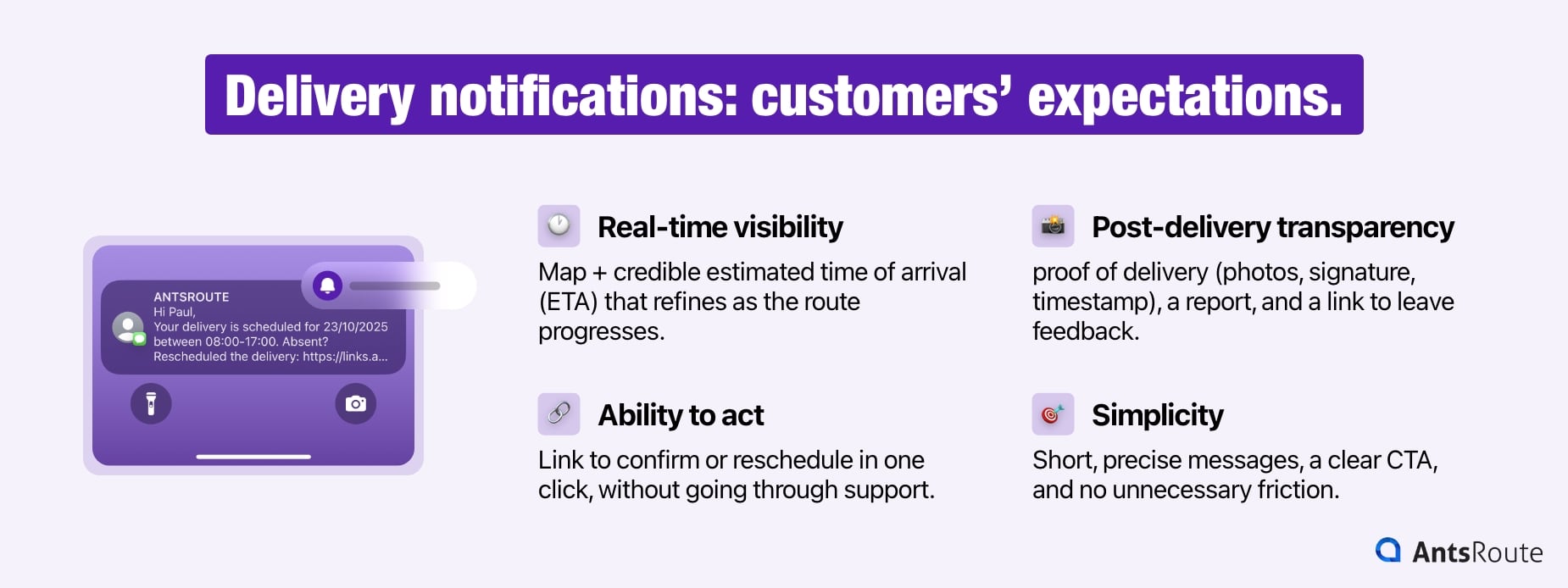
Delivery notifications: customers’ expectations.
Setup in AntsRoute: step-by-step guide
To help you set up high-performing notification templates in AntsRoute, here’s a step-by-step tutorial. This guide walks you through enabling the right channels, creating robust templates, defining precise triggers, and measuring your results. In under 30 minutes, you can configure all the templates mentioned in part four of the article.
Step 0: Prerequisites to save time
Before you begin, make sure you have:
- The right access: admin role, or at minimum permissions for Settings > Notifications.
- Up-to-date data: recipients’ first name, email, and mobile number.
- Ready pages: customized tracking and confirmation/rescheduling pages (logo, colors, legal mentions). Consistent branding reassures customers and improves click-through rate.
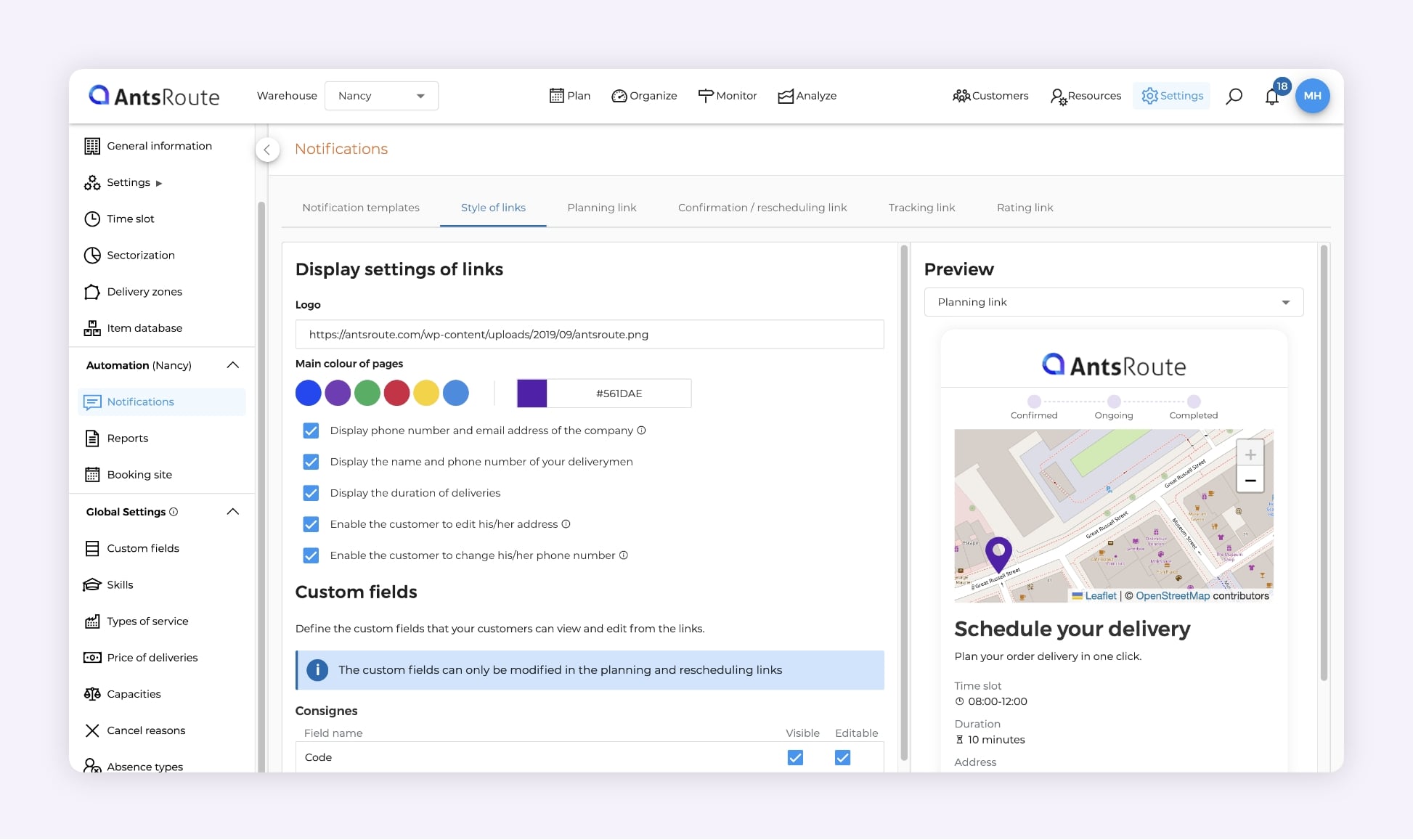
Customizing the tracking and confirmation/rescheduling pages on AntsRoute.
Step 1: Configure action links (scheduling, rescheduling, tracking, rating)
Before you even create your templates, start by structuring the links that turn a notification into an action (schedule, track, reschedule, rate).
Go to Settings > Notifications > Links and define:
- Link validity period: The time during which the link remains clickable (e.g., 7, 14, or 30 days).
Recommendations: 14 days for scheduling invitations, 48 to 72 h for rescheduling, 24 h for rating to capture “in-the-moment” feedback. - Title: Displayed at the top of the page. Be descriptive and action-oriented.
Examples: “Choose your delivery time slot,” “Track your driver’s arrival,” “Give your feedback on the delivery.” - Description: A short bit of context (1 to 2 sentences) that, for example, reminds users of a key instruction.
Recommendations: Mention your brand and the benefit (“reschedule in 1 click”). - Maximum allowed detour (km) to add a delivery.
- Allowed scheduling/rescheduling time slots
Recommendations: exclude non-productive periods, avoid overly wide windows (prefer 9 to 11 a.m. rather than 8 a.m. to 6 p.m.), and offer up to 4 relevant options. - Download of the service report from the tracking/rating link: Enable access to the report (photos, signature, timestamp) directly from the tracking/rating page.
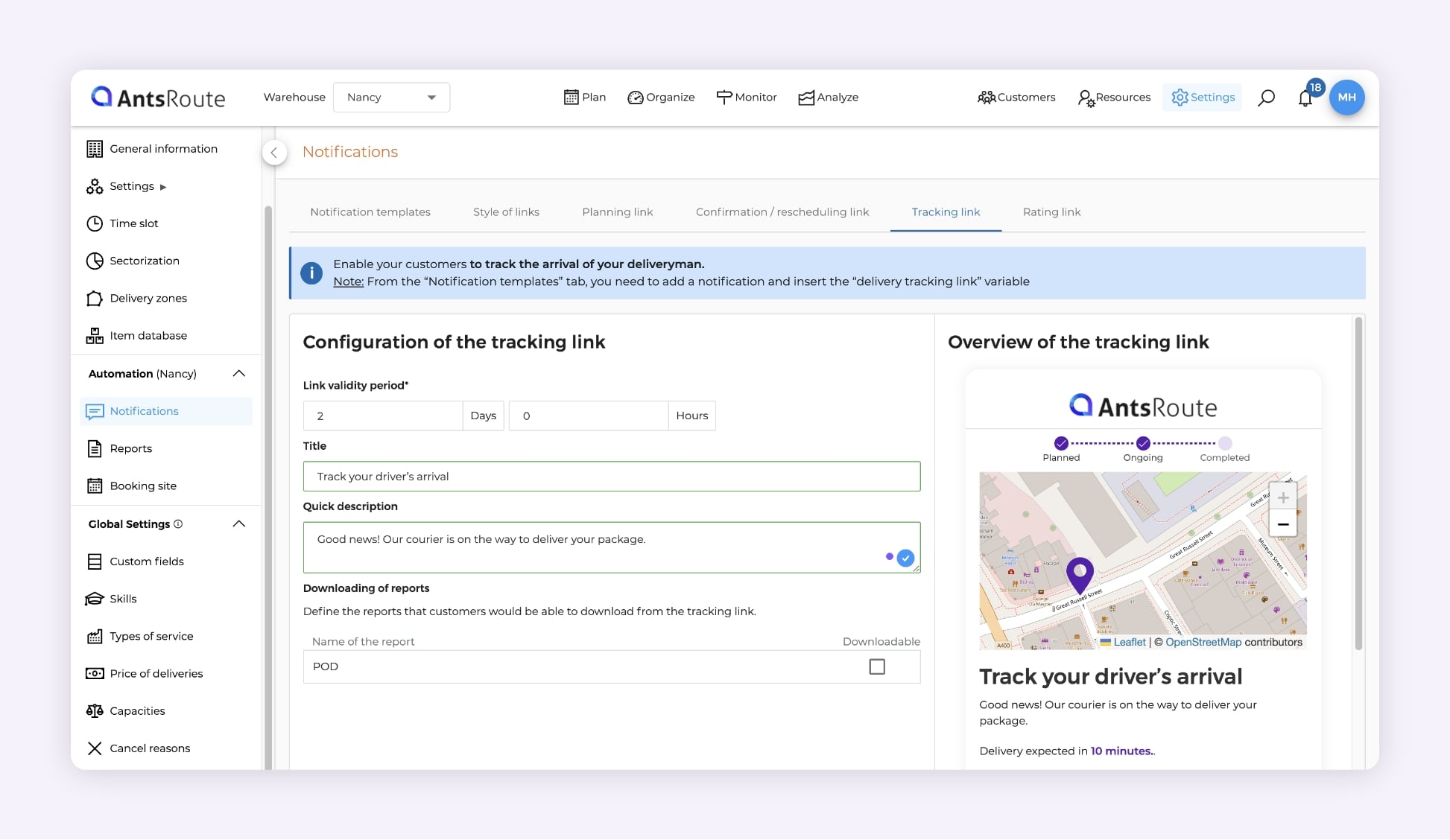
Configuring the tracking link in AntsRoute.
Step 2: Configure templates (content, channel, triggers, variables)
Once your action links are in place, create your list of templates via Settings > Notifications > Notification templates. For each template, provide:
1️⃣ Type (delivery channel):
- SMS for time-sensitive information (route departure, approaching, unexpected events).
Recommendation: keep it under 160 characters to avoid splitting into multiple SMS messages. - Email for consultative content (confirmation, service report, review request).
Recommendation: pay attention to the sender name and the subject line.
2️⃣ Trigger (use case):
- Scheduling, confirmation/rescheduling: triggered by an action from AntsRoute.
- Route departure (tracking): at the start of the route.
- Driver approaching (refined ETA): when the previous stop/delivery is validated (ETA recalculated).
- Disruption (delay/cancellation): when a delivery is canceled or via an action from the mobile app.
- After the visit (report & review): when a delivery is validated.
3️⃣ Write the content and insert variables:
Use variables to personalize each message:
- $firstName: first name
- $id: order/delivery reference
- $timeSlot: time slot (e.g., 9–11 a.m.)
- $arrivalTime: estimated time of arrival (ETA)
- $trackUrl: real-time tracking link (use in “Route departure” and repeat in “Driver approaching”)
- $confirmRescheduleUrl: confirmation/rescheduling link (use in “Scheduling” and “Confirmation/Rescheduling”)
- $reportUrl: service report link (photos/signature) for “After the visit”
- $reviewUrl: rating link (NPS/feedback) for “After the visit”, etc.
Step 3: Go live and monitor (KPI-driven)
For 2–3 weeks, track your metrics and iterate:
- % self-scheduling
- First-attempt success (presence on first visit)
- Clicks on the tracking link
- Reduction in inbound calls (“Where is my delivery?”)
- Post-visit NPS
Adjust as needed: send windows, message/CTA content, and the time slots offered.
The ideal notification journey: from first contact to feedback
A coherent journey beats a pile of messages. Here’s the sequence that works best in most cases:
- Schedule / confirm: via a secure link, the customer chooses their delivery time slot or confirms the proposed one.
- Reminders before delivery day: one message the day before, then another on the morning itself to prevent no-shows.
- Route departure: send a real-time tracking link with an initial arrival window to reduce uncertainty.
- Approaching: provide a refined ETA (e.g., 15–25 minutes) to encourage the recipient to be available and ease access.
- Change / cancellation: proactively inform in case of disruption, with an immediate rescheduling option.
- After the visit: send a downloadable report (photos, signature, timestamp) and a prompt for on-the-spot feedback.
This logic aligns with market best practices: contextual notifications sent at the right moment and geared toward a simple action, rather than generic messages.
They use it
“Automatic notifications, along with photos, customer details, signatures, and any comments, ensure total transparency. Leroy Merlin and their end customers can view the status of their deliveries live.” — Franck Dalet, Manager, Transport Dalet
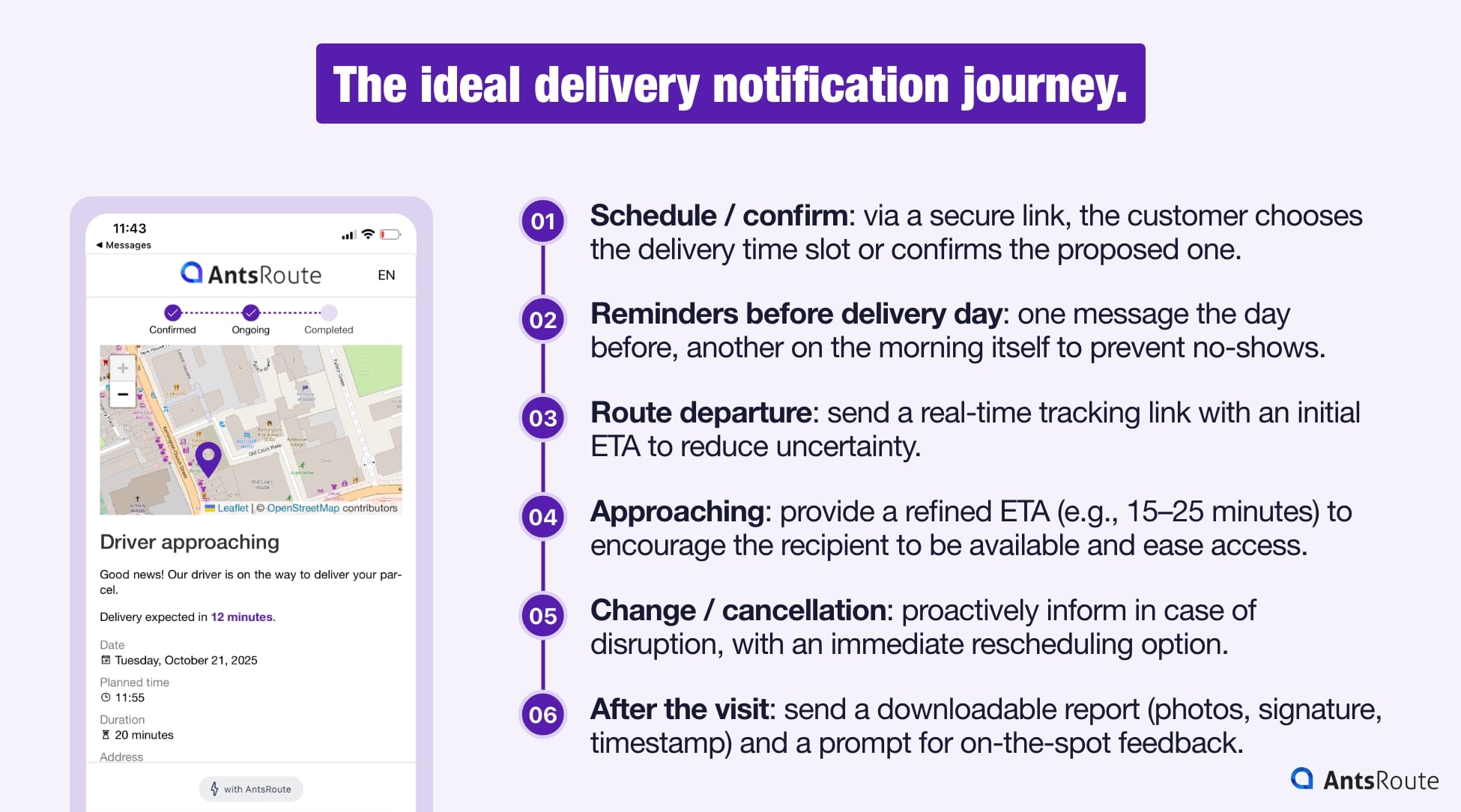
The ideal delivery notification journey.
Summary table of AntsRoute notifications
| Stage | Trigger | Content type | Channel | Action /CTA | Objectives | Support article |
| Customer self-scheduling | New order without a time slot — Triggered by an action from AntsRoute. | “Choose your time slot” + address + time window | SMS /E-Mail | Schedule an appointment | Self-service, fewer calls. | Link to article |
| Appointment confirmation | Appointment created / confirmed — Triggered by an action from AntsRoute. | Date & time summary | SMS /E-Mail | Add to calendar | Reassurance | Link to article |
| Reschedule / confirm | Proposed or updated time slot — Triggered by an action from AntsRoute. | Time slot + confirm/reschedule link | SMS /E-Mail | Confirm / Reschedule | Less no-shows | Link to article |
| Pre-visit reminder | D-1 / morning of visit — Triggered by an action from AntsRoute. | Time slot + instructions | SMS /E-Mail | Need to change? | Make the customer ready | Link to article |
| Route departure | Driver start — Automatic at the start of the route | Tracking link + ETA + position in the route | SMS /E-Mail | Track arrival | Reduce uncertainty | Link to article |
| Approaching | Agent nearby — Triggered by validation of the previous delivery / by an action from the mobile app | Refined ETA (e.g., 15–25 min) + options | SMS /E-Mail | – | Boost presence | Link to article / Link to article |
| Cancellation | Cancellation of a delivery | Reason + indicate a new proposal will follow | SMS /E-Mail | – | Transparency | – |
| After the visit — Service report | Validation of a delivery | Report link (photos, signature, timestamp) | SMS /E-Mail | Download the report | Proof of delivery | Link to article |
| After the visit — Review | Validation of a delivery | Review request (rating + comment) | SMS /E-Mail | Leave a review | Feedback / NPS | Link to article |
Ready-to-use message templates
1. SMS: Customer self-scheduling
Hi {{firstName}}, choose your delivery time slot for {{id}}: {{scheduleURL}}.
Need help? Contact {{enterpriseName}}.
2. Email: Appointment confirmation
Subject : Your appointment is confirmed ✅
Body : Hi {{firstName}},
Your delivery {{id}} is confirmed for {{ScheduledDate}} at {{arrivalTime}}.
The parcel will be handed over upon providing a code: {{customField_Code}}.
Need to make changes? {{confirmRescheduleUrl}}
3. SMS: Route departure (live tracking)
Hi {{firstName}}, your delivery {{id}} is underway. Estimated arrival time: {{arrivalTime}}. Track your driver here: {{trackUrl}}.
4. SMS: Approaching (refined ETA)
Hi {{firstName}}, our driver will arrive in {{waitingTime}} min. Please make yourself available.
5. Email: Delivery cancellation
Subject : Cancellation of your appointment on {{scheduledDate}}
Body : We’re sorry, your delivery {{id}} scheduled for {{ScheduledDate}} has been canceled.
We’ll contact you to schedule a new appointment.
More information? Contact the team at +44 7700 900721
6. After the visit (report + review)
Subject: Delivery completed: your report & your feedback
Body: Hi {{firstName}}, your delivery on {{scheduledDate}} at {{arrivalTime}} is complete.
Download the report (photos/signature/parcel details): {{reportUrl}}.
Tell us how it went: {{reviewUrl}}.
They use it
“Customers are automatically informed about the progress of their order, which greatly streamlines deliveries.” — Raphaël Blandin, Transport Freemann
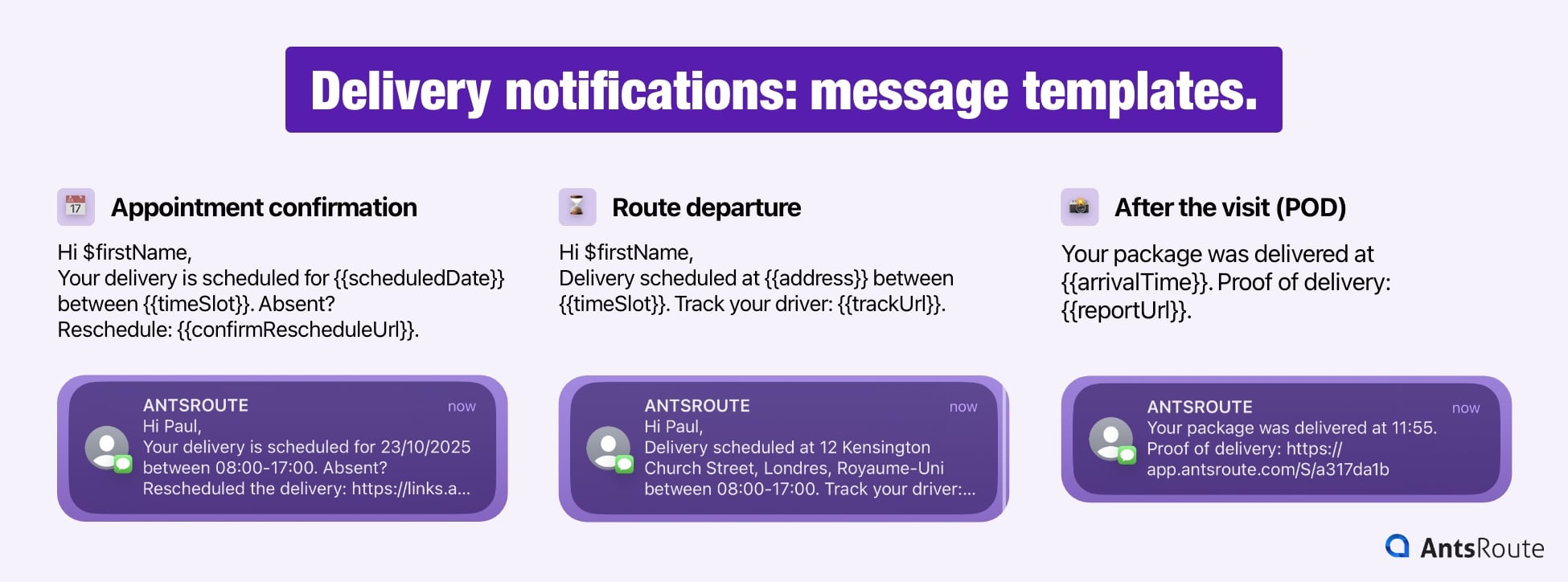
Message templates sent via AntsRoute.
UX best practices (content, timing, channels)
Before fine-tuning your templates, keep one simple idea in mind: every notification should drive the right action, at the right time, through the right channel.
Great customer experience isn’t just a nice line, it’s a message you grasp in 2–3 seconds, sent when you can act, with a clear link (tracking, rescheduling, report) that makes the customer’s life easier.
The rules below help you maintain this level of quality, no matter the volume you send.
- Absolute clarity: one message = one goal = one CTA. Avoid long-winded sentences and, if you must offer multiple options (track / reschedule), rank them and highlight the primary action.
- Useful variables: essentials are first name, the time slot (or ETA), the address, and a direct link to the expected action (tracking, rescheduling, report). Variables must be reliable and always up to date: a broken link or vague time window destroys trust faster than a generic message.
- Tone and length: for SMS, aim for <160 characters when possible to avoid splitting into multiple messages. Prefer a direct, concrete style (“Your driver arrives in 20-30 min. Track: {link}”). In email, stay concise above the fold and keep details (instructions, extra fields) below.
- Send windows: respect quiet hours (no nighttime SMS) and trigger reminders when the customer can actually act: D-1 to plan their presence, morning-of to confirm, and on approach so they can make themselves available. Adjust these windows to your sector (e.g., B2B vs. home delivery).
- Information hierarchy: in email, a descriptive, recognizable subject line (“Your delivery is on the way”) improves opens; a preheader that states the ETA adds context; and a visible CTA placed above the fold speeds action.
- Controlled multichannel: choose the channel based on urgency. SMS is ideal for time-sensitive info (route start, approach, last-minute changes). Email is better for consultative content (appointment recap, post-visit report, review request). Avoid unnecessary duplicates: sending the same message by SMS + email at the same moment fatigues users. Instead, prefer a sequence (immediate SMS, then a confirmation email).
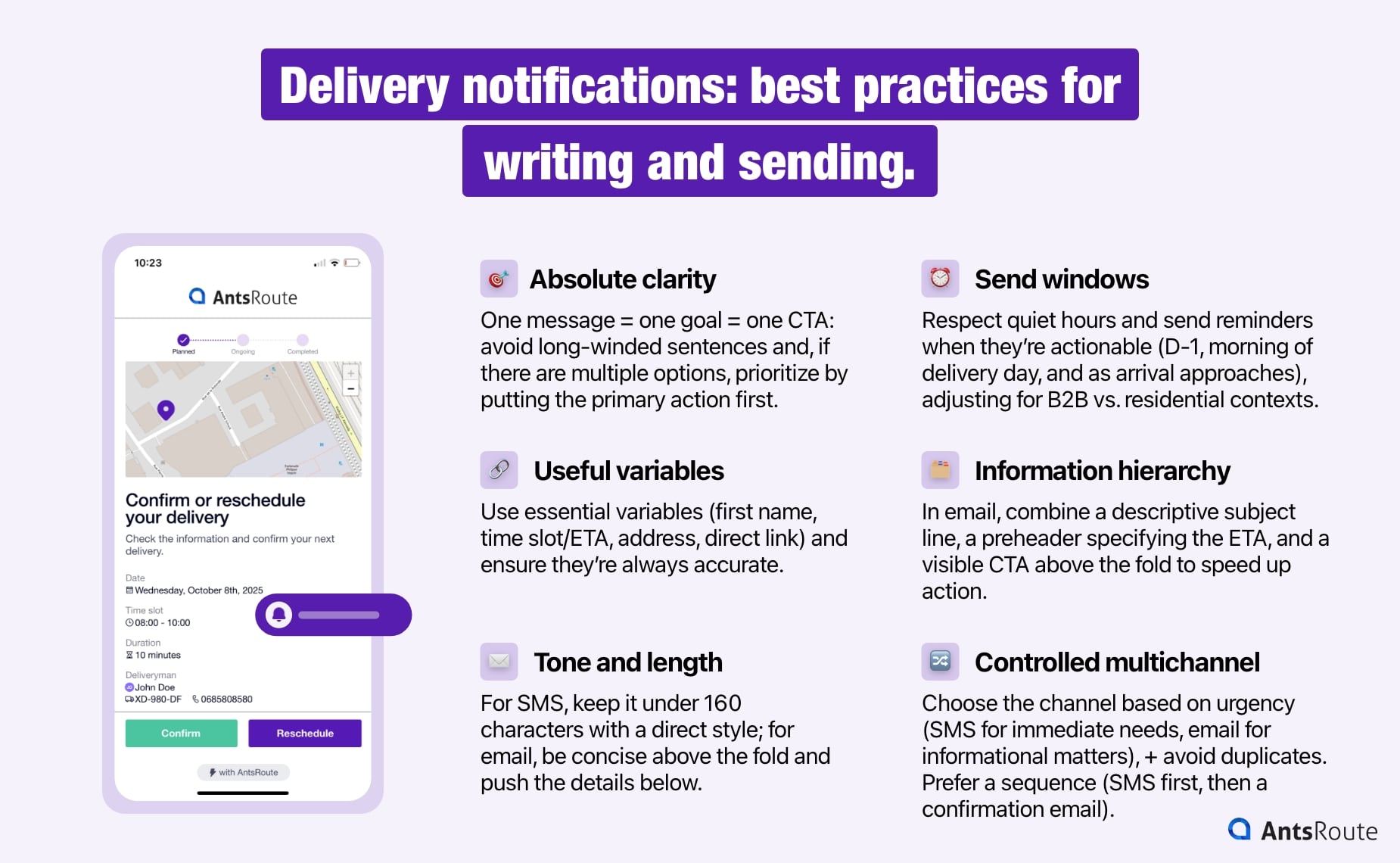
Delivery notifications: best practices for writing and sending.
Measuring impact: the KPIs that matter
The 5 metrics to analyze
The goal is to set a starting baseline, i.e. your numbers before the rollout. Then track a few simple, useful metrics. The point isn’t to measure everything, but to tie each notification to a concrete outcome: presence on the first visit, fewer calls, higher satisfaction.
☝️ Useful link: see our article on the impact of delivery notifications on the customer experience.
Self-scheduling rate:
Measures the share of appointments booked by customers themselves via your links (scheduling + rescheduling).
➡️ Formula: Deliveries scheduled via link ÷ Scheduling links sent.
➡️ How to use it: If the metric stalls, test the link placement, the CTA clarity (“Choose my slot”), or the message send time.
Presence rate (first-attempt success):
Share of customers present on the first attempt.
➡️ Formula: Deliveries completed on first visit ÷ Scheduled deliveries.
➡️ How to use it: Track the change before/after your D-1/D-day reminders and the “Approaching” notification. If the rate doesn’t improve, tighten your ETA windows.
Open and click-through rate:
Track the percentage of links opened as your primary indicator of interest, whether the message is sent by SMS or email. It’s your “true” engagement signal.
Also look at the action rate after the click.
➡️ Example formula for a scheduling link: Deliveries scheduled ÷ links sent.
Reduction in inbound calls:
Compare the volume of “Where is my delivery?” calls before/after rolling out reminders, live tracking, and the approaching alert.
➡️ How to use it: if the decrease is small, review the tracking page (is a key piece of info missing: ETA, access code, contact?).
Post-visit NPS:
On-the-spot satisfaction score via the “Review” notification.
➡️ How to use it: correlate NPS with send types (e.g., presence of a detailed service report) and send-time windows to spot areas for improvement.
Table of actions to implement when KPIs decline:
| Declining KPI | First thing to test |
| Self-scheduling rate | Clearer CTA, send time, visible time slots |
| Presence rate (first-attempt success) | Approaching message, tighter ETA, precise instructions |
| % of links opened | Descriptive email subject / shorter SMS, link higher up |
| Inbound calls | Richer tracking page (ETA, contact, instructions) |
| NPS | Quality of the report, drivers’ punctuality and attitude |
Statistics on AntsRoute notifications
AntsRoute route-optimization software provides a set of statistics and KPIs on notifications sent to customers.
Scheduling links
- % of links opened: Scheduling links opened ÷ Scheduling links sent.
- % of deliveries scheduled: Deliveries scheduled via link ÷ Scheduling links sent.
Confirmation / rescheduling links
- % of links opened: Confirmation/rescheduling links opened ÷ Confirmation/rescheduling links sent.
- % of deliveries confirmed: Deliveries confirmed via link ÷ Confirmation/rescheduling links sent.
- % of deliveries rescheduled: Deliveries rescheduled via link ÷ Confirmation/rescheduling links sent.
Tracking link
- % of links opened: Tracking links opened ÷ Tracking links sent.
Review link
- % of links opened: Review links opened ÷ Review links sent.
- % of reviews submitted: Reviews received ÷ Review links sent.
Clear notifications, sent at the right moment and tied to simple actions (tracking, rescheduling, review), turn delivery into a smooth experience, both for customers and your team. With AntsRoute, you can set up this journey in just a few steps: activate the three key notifications (departure, approach, post-delivery), offer self-service rescheduling, and track results weekly.
Ready to try it on your routes? Start your free trial and see the impact for yourself, then choose the plan that fits.
➡️ Request a demo.
➡️ View pricing.
FAQ – A 5-star customer experience with AntsRoute notifications
First, customize the page linked to your tracking URL in AntsRoute. Then create a “Route departure” notification template and set its trigger to the start of the route. Insert your variables and the tracking link in the message. As soon as a driver starts their route from the mobile app, all customers scheduled for the day automatically receive the notification.
Yes. Use the confirmation/rescheduling notification with a secure link. The customer can choose a new time slot in a few clicks. When configuring the link, you define the allowed time slots and the maximum detour (in kilometers) your teams accept.
Yes. As the route progresses, the ETA updates automatically on the tracking page and in the “agent approaching” notification, increasing accuracy and customer trust.
Yes. From the AntsRoute interface, the scheduler can send an on-demand notification to the customer (delay, access, change). In the field, the driver can also send a message directly from the mobile app if something unexpected occurs.
WRITTEN BY

Marie Henrion
At AntsRoute, Marie has been the marketing manager since 2018. With a focus on last-mile logistics, she produces content that simplifies complex topics such as route optimization, the ecological transition, and customer satisfaction.
Free 7-day trial | No credit card required
Contenu
- What your customers really expect
- Setup in AntsRoute: step-by-step guide
- Step 0: Prerequisites to save time
- Step 1: Configure action links (scheduling, rescheduling, tracking, rating)
- Step 2: Configure templates (content, channel, triggers, variables)
- Step 3: Go live and monitor (KPI-driven)
- The ideal notification journey: from first contact to feedback
- Summary table of AntsRoute notifications
- Ready-to-use message templates
- UX best practices (content, timing, channels)
- Measuring impact: the KPIs that matter
- The 5 metrics to analyze
- Statistics on AntsRoute notifications
- FAQ – A 5-star customer experience with AntsRoute notifications

